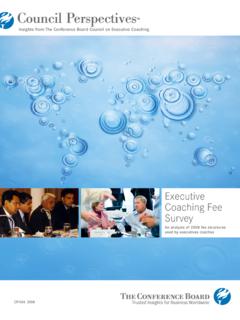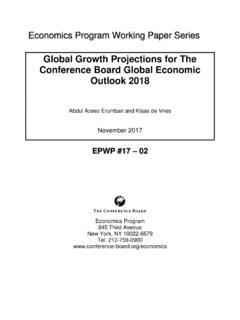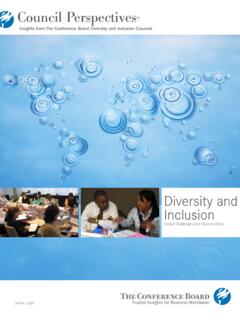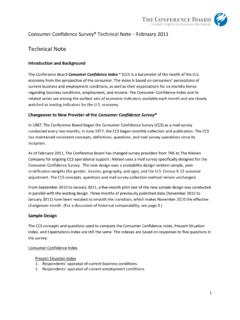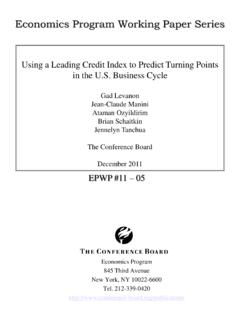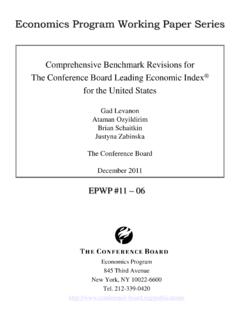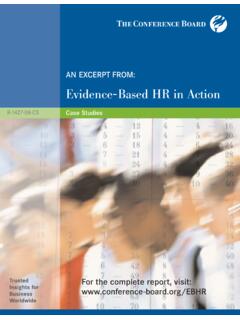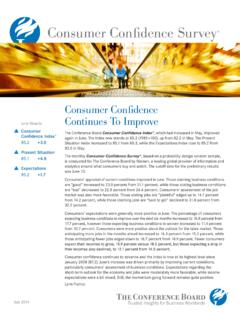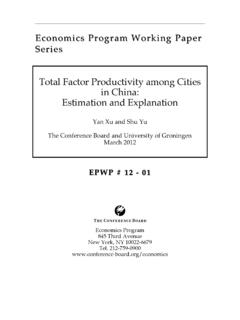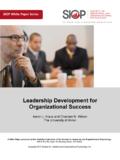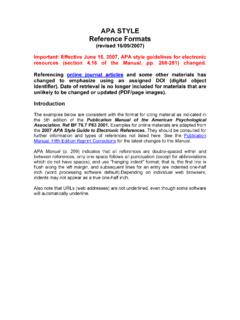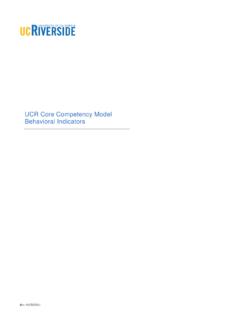Transcription of Creating a Competency Model for Diversity and Inclusion ...
1 Council Perspectives TM. Insights from The Conference Board Council on Workforce Diversity Creating a Competency Model for Diversity and Inclusion Practitioners CP-005 2008. Council Perspectives TM. Members of The Conference Board Councils are among the most experienced and savvy executives in the world. Their private deliberations produce rich insights on the most challenging business and societal issues of our time. With their permission, we have channeled their energy and expertise into a platform to voice their views that platform is Council Perspectives. Council Perspectives is based on sessions from selected Council meetings, post-meeting interviews, and other pertinent data, and may sometimes include original content written by Council members.
2 It is not intended to be a research report; rather, Council Perspectives provides a unique look into the minds of executives from leading global organizations as they assess, analyze, and develop ways to address critical issues. Creating a Competency Model for Diversity and Inclusion Practitioners By Indra Lahiri Contents 4 Executive Summary 6 Diversity and Inclusion Practitioner Competencies 8 The Need for a New Set of Competencies 10 Global Diversity and Inclusion Competency Model 11 Change Management 12 Diversity , Inclusion , and Global perspective 14 Business Acumen 15 Strategic External Relations 16 Integrity 17 Visionary & Strategic Leadership 18 HR Competencies 19 Proficiency Levels 22 Metrics 22 Conclusion 23 Survey 24 Acknowledgments 25 About this Report 25 About the Author 26 A Note of Thanks 4 C o u n c i l Pe r s p e c t i v e s - C r e a t i n g a C o m p e te n c y M o d e l fo r D i v e r s i t y a n d I n c l u s i o n P r a c t i t i o n e r s w w w.
3 C o n fe r e n c e - b o a r d . o r g Executive Summary Ten years ago, the word Inclusion was rarely used, and The Competency Model contained in this report is the only by a few organizations. Now, the phrase Diversity result of an intensive, two-day working session of The and Inclusion has its own acronym D&I. Focus has Conference Board's Council on Workforce Diversity , progressed from valuing differences, which was largely with representatives from the Diversity & Inclusion achieved through awareness training and multi-cultural Council and the Diversity Business Council. In prepara- celebrations, to strategic global business growth. tion for this session, members of all Diversity Emphasis today is on cornering new markets, building Councils were invited to share their perspectives via a effective and efficient global teams, and managing brand brief survey.
4 Seventy-six individual respondents shared reputation. Clearly, the 21st century D&I practitioner, their thinking on competencies required of a D&I practi- embracing this more public, decidedly strategic role, tioner today. Forty-four of these, or 77 percent, work for requires a challenging new set of competencies. organizations with global operations. (A copy of the sur- vey can be found on page 23.) During the working ses- sion, council members used results from this survey There are five primary trends driving changes in the D&I as a springboard, shaping the Model through rigorous dis- practitioner's role and that define the need for new think- cussions.
5 Members of the European, Asian, and Canadian ing regarding competencies. These are: Councils and the staff who support them provided feed- back and perspective on drafts of the Model and this Globalization report. The Model was then shared with colleagues from Demographic shifts across the globe, who provided feedback on its relevance and applicability. Technology Legal environment The Model includes 1) categories of like competencies, 2). Socio-political climate the competencies themselves, and 3) behaviorally-based definitions for each Competency . The seven categories In order to hire and manage D&I executives, to say noth- and their related competencies are: ing of completing succession plans that ensure the func- tion's long-term viability, a set of globally applicable, 1.
6 Change Management measurable competencies for D&I practitioners at multi- organizational Development ple levels is needed. Corporate Communication Critical Interventions 2. Diversity , Inclusion , and Global perspective Cultural Competence Negotiation and Facilitation Continuous Learning Complex Group Dynamics Judgment Subject Matter Expertise w w w. c o n fe r e n c e - b o a r d . o r g C o u n c i l Pe r s p e c t i v e s - C r e a t i n g a C o m p e te n c y M o d e l fo r D i v e r s i t y a n d I n c l u s i o n P r a c t i t i o n e r s 5. 3. Business Acumen External Market Knowledge Holistic Business Knowledge Diversity and Inclusion ROI. (Return on Investment).
7 4. Strategic External Relations Corporate Social Responsibility /. Government / Regulatory Strategic Alliances Diverse Markets / Supplier Diversity Brand / Reputation Management 5. Integrity Ethics Resilience To be used effectively, these competencies should be inte- Influence grated into a company's business metrics. Organizations Empathy would do best to customize simple, clear measures that are part of an organization's overall metrics for each of the Communication global Diversity competencies, or even for each category. 6. Visionary & Strategic Leadership While defining these measures is beyond the scope of this Diversity & Inclusion Future State report, organizations should be asking the question: how can this person use this Competency to strengthen the busi- Pragmatism ness?
8 Or, what does this person need to achieve to further Political Savoir-Faire (At HQ and Local Levels) our organizational goals? 7. HR Disciplines Total Rewards / Talent Management /. By attaching simple, business-based metrics to each com- organizational Development / Work and Life Balance / Training petency, or even to each Competency category, organiza- tions lay the foundation for D&I practitioners to achieve Compliance success, thereby best supporting organizational goals. Employee Relations 6 C o u n c i l Pe r s p e c t i v e s - C r e a t i n g a C o m p e te n c y M o d e l fo r D i v e r s i t y a n d I n c l u s i o n P r a c t i t i o n e r s w w w.
9 C o n fe r e n c e - b o a r d . o r g Diversity and Inclusion Practitioner Competencies 1 Change Management 2 Diversity , Inclusion , and Global perspective 3 Business Acumen organizational Development Cultural Competence External Market Knowledge Understands and facilitates the Understands multiple cultural frameworks, values, and norms Understands and is current on change process through completion global and local trends/ changes Demonstrates an ability to flex style when faced with myriad and how they inform and Gains leadership involvement and dimensions of culture in order to be effective across cultural influence D&I. line ownership contexts Gathers and uses competitive Understands the dynamics of cross-cultural and Inclusion - intelligence Corporate Communication.
10 Related conflicts, tensions, misunderstandings, or opportunities Communicates the full spectrum Understands diverse cus- Understands the history, context, geography, religions, and lan- tomer/client needs of Inclusion guages of the regions in which the organization does business Utilizes multiple communication Understands and is current Is fluent in more than one, and ideally several, languages with global socio-political vehicles such as web sites, brochures, talking points, and more environments Negotiation and Facilitation Maintains a balanced global per- Understands context and spective that offers flexibility and Negotiates and facilitates through cultural differences, conflicts, lessons learned tensions, or misunderstandings variations for use at the local level Keeps what is best for the business Holistic Business Knowledge Continuous Learning at the forefront Understands the impact of the Recognizes and addresses one's filters, privileges, biases, and financial, economic.
